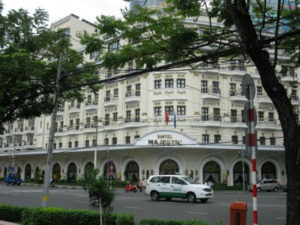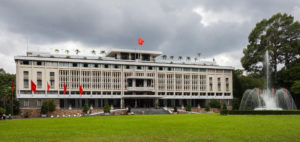| Visiting Saigon in 1973 during the War
Surviving in War |
| 1973 in Saigon (Credit: Saigoneer)
Justice Initiative March 7, 2023 Introduction
This article is about the Vietnam War in the 1970s and about my 1973 visit to Vietnam during the war. It is a revised version of my previous article about my visit to Saigon. Given the on-going war against the Ukrainians by Russia, I thought I would yet again share information about the war against the Vietnamese by the United States in the 1970s. The horrors and tragedy of war overall cannot be underestimated and the impact of it all needs to shared and understood as much as possible so that hopefully, in the future, wars can be prevented.
In 1968, I left the United States for Australia where I was married to my Australian fiancé and where I began a whole new adventure in life and I admit I was so glad to leave the United States at that time. I thought surely there’s got to be something better than the stress and violence we witnessed in the United States in the 1960s decade. But I learned otherwise. What I learned was that wherever you are in the world, one way or the other, some people will be treated unjustly, including oppression of women, I might add, and that there is always a need to work both “against” oppression and “for” justice.
Think for a moment, however, about the violence in the United States in the 1960s and corresponding US interventions in Southeast Asia and other parts of the world during this period. To name but a few incidents: there was the on-going Vietnam War since 1955 leading to violence in Laos and Cambodia as well; the disastrous Bay of Pigs invasion in Cuba in April 1961; the assassination of President John Kennedy in November 22, 1963; the 1964 violence in Panama, when the US insisted on having control of the Panama Canal and 6 miles surrounding it, leading to violence and the death of 22 Panamanians and 4 US soldiers; the US inspired overturning of the Sukarno government in Indonesia in 1967; the riots against the Chinese in Malaysia in 1969 with the US CIA and other secret service entities implicated. Invariably there was huge loss of life and injustice with all of these incidents and US interventions combined.
In 1967 there was also the Arab-Israeli War:
“The 1967 Arab-Israeli War marked the failure of the Eisenhower, Kennedy, and Johnson administrations’ efforts to prevent renewed Arab-Israeli conflict following the 1956 Suez War. Unwilling to return to what National Security Advisor Walter Rostow called the “tenuous chewing gum and string arrangements” established after Suez, the Johnson administration sought Israel’s withdrawal from the territories it had occupied in exchange for peace settlements with its Arab neighbors. This formula has remained the basis of all U.S. Middle East peacemaking efforts into the present…between June 5 and June 10, Israel defeated Egypt, Jordan, and Syria and occupied the Sinai Peninsula, the Gaza Strip, the West Bank, East Jerusalem, and the Golan Heights.”
In 1967, I participated in the “Anti-Vietnam War March Against the Pentagon” in Washington DC. Four of us Atlantans drove up to Washington in my red Volkswagen. Atlanta activist Rick Brown drove the car while I sat in the back playing my guitar along with another Atlanta activist Jim Skillman who was already a Vietnam veteran. I was impressed with the Washington, DC organizers of the event who arranged housing for all of us thousands of folks coming in from throughout the country for the event. I must say that marching against the war on the Washington, DC streets with thousands of others was exhilarating.
I left the United States in August 1968. It was the year that Martin Luther King was assassinated on April 4, and I was involved with SNCC in helping to organize the funeral; Bobby Kennedy was assassinated on June 6, 1968; then there were demonstrations against the Vietnam War at the Democratic Convention on August 28, 1968:
(On August 28, 1968) at the Democratic National Convention in Chicago, tens of thousands of Vietnam War protesters battle police in the streets, while the Democratic Party falls apart over an internal disagreement concerning its stance on Vietnam. Over the course of 24 hours, the predominant American line of thought on the Cold War with the Soviet Union was shattered. (History.com)
The interesting thing is that once in Australia and settled ultimately in Wollongong, Australia (just south of Sydney), I began marching against the Vietnam War with Wollongong activists many of whom were not only Australians, but also other Americans and those from Britain, Mexico, Yugoslavia, Italy and the Netherlands. I also began assisting migrant women in need, as well as being engaged with the Australian National University on research of laborers, who were mostly migrants, at the huge Wollongong steel mill – “Australian Iron and Steel”.
So it was true that being away from the states I but joined yet another group of impressive activists in Australia. Suffice it to say, as mentioned previously, I learned in my 20s that you could never get away from the impacts of international state violence and the need to take a stand for justice and compassion.
Visiting and learning about Saigon in 1973
When I first wrote about my experience in Vietnam, it was in 2007 when George Bush wanted to escalate the war in Iraq. At the time I thought I would share something about my experience in Vietnam to place war somewhat in the context of daily life. With the Ken Burns series about the Vietnam War being shown in 2017 on PBS, I thought I would yet again revisit and share my experiences in Saigon in 2017 which I when I wrote the next version of this article. And now in 2023 with the war against Ukraine by Russia I am yet again sharing information about the Vietnam War.
The image of war can be so deceptive. This likely is true whether in Iraq, Palestine, Lebanon, Somalia, Vietnam, Ukraine or wherever the conflict might be. I used to naively think that life would be close to suspended for those living in war torn countries. But even in war, I ultimately learned, people will attempt to take care of their youngest children and other vulnerable members of their family, engage in commerce, and explore every conceivable way to survive. There really is no other choice! That’s what I learned in Saigon (now Ho Chi Minh City) in 1973, close to end of the Vietnam War travesty. |
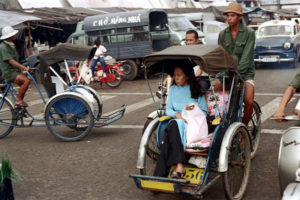 |
| 1973 in Saigon (Credit: Saigoneer)
There was probably nothing in the city of Saigon in 1973 comparable to the dreadful violence that plagued Baghdad and now other areas in the Middle East, both in terms of the violence from civil strife or by the invasive U.S military against the people. But even and especially in these war torn countries, people need to figure out a way to feed and take care of their own.
Saigon was somewhat of a safe haven with war raging around it in the rural areas. The Viet Cong seemingly had no interest, even if they had the weapons to do so, in destroying Saigon in retaliation against the US for the devastating bombing of Hanoi. There could have been the justification, however, for the destruction of Saigon as it was one of the US bases of operations and, with its beautiful French boulevards and other French architecture, in retaliation for the hundreds of years of French interference and colonialism.
It was impossible in 1973 to go into the Vietnamese hinterlands except on planes, as Saigon’s “Highway One” was too dangerous and the planes were booked solid. So I stayed in Saigon for a week where there was, of course, a curfew. There’s nothing like sitting in a restaurant while listening to bombs dropping from just outside the city. The bombs always seemed to drop at night and seemed close, which I guess they were.
In spite of all this, however, I found much in Saigon I didn’t expect. There were parts of the city where there were, thankfully, no apparent signs of war. Yet in most areas of downtown Saigon, sandbags lined the streets and the armed Vietnamese military were at virtually every intersection. Yet, life went on.
The Vietnamese are resilient. They have, after all, been resisting occupation and foreign invaders for centuries, from the Chinese to the French, the Japanese and the Americans. But almost everyone I met in Saigon, whether they were Vietnamese or not, were trying to circumvent the war and the violence surrounding them which is something I think most of us would attempt.
In the early 1970’s I lived in Singapore with my husband – an Australian diplomat – and our young son. We were in an apartment building that was rather a mecca for international journalists who were traveling back and forth to Vietnam, Cambodia or elsewhere to report on the war. New York Times reporter Sydney Schanberg and his wife Janice were in that mix, as well as U.S. News and World Report journalist Jim Wallace and his wife Haya Wallace who lived two floors above us.
While we were in Singapore, Schanberg was spending most of his time in Cambodia and reporting on the tragedy unfolding in that beleaguered country that, unfortunately, bordered Vietnam. The illegal bombing of Cambodia by the Nixon administration had begun in April of 1970 and the consequences of it all were devastating. It’s thought to have been a major catalyst of political instability leading to the downfall of the Prince Norodom Sihanouk government and the rise of Pol Pot and the Khmer Rouge. For his reporting on Cambodia and his subsequent book, “The Killing Fields,” Schanberg won the Pulitzer Prize. In it he depicted the tragic violence of the Khmer Rouge and the estimated killing of 2 million Cambodians. Janice Schanberg was understandably worried about her husband as he ventured back and forth to Cambodia. The Schanberg’s were the last couple I dined with before leaving Singapore in December 1973.
Haya Wallace’s parties were legendary. She was an antique collector and her apartment was filled to the brim with Southeast Asian collectibles. I recall sitting in her apartment in a small cozy area designated for social gatherings, while all around there were sculptures from Papua New Guinea, lamps from Indonesia, pottery from Malaysia, contemporary Singaporean paintings, and Chinese crafts of every sort, including a huge beautifully crafted Chinese wedding bed in the middle of her living room.
When the opportunity arose to visit Saigon in January 1973, I jumped at the chance. Haya was going with her husband and other journalists to Saigon and she asked me to join her. She was to seek antiques in Saigon. So here we were, in the major city of a war torn country and traipsing around it’s remarkable antique stores and there were a lot of them. It was rather surreal experience to say the least. This also included joining journalists for meals in exquisite Vietnamese and French restaurants. It was rather hard to believe that in the middle of war, here I was eating some of the best food on the planet.
The influence of France in Vietnam apparently began with Jesuit priests in the 1600’s and ultimately the French occupation of Vietnam under Napoleon III in 1853. It lasted until 1954, in the midst of Vietnamese resistance. (When is there not resistance to occupation? It’s time the Americans learned this!) In this exquisite Asian city, the legacy of French occupation was apparent. There were all kinds of French restaurants, and shopkeepers selling loaves of French bread and everything else French. I drank wine on the veranda of one of the hotels – the Hotel Majestic – frequented earlier in the 1930s by British writer Somerset Maugham. Vietnamese or French were the languages. As I unfortunately do not speak the beautiful song-like Vietnamese language, I spoke with most cab drivers in French. English was virtually a non-entity. |
| Your copy should address 3 key questions: Who am I writing for? (Audience) Why should they care? (Benefit) What do I want them to do here? (Call-to-Action)
Create a great offer by adding words like “free” “personalized” “complimentary” or “customized.” A sense of urgency often helps readers take an action, so think about inserting phrases like “for a limited time only” or “only 7 remaining”! |
| Your copy should address 3 key questions: Who am I writing for? (Audience) Why should they care? (Benefit) What do I want them to do here? (Call-to-Action)
Create a great offer by adding words like “free” “personalized” “complimentary” or “customized.” A sense of urgency often helps readers take an action, so think about inserting phrases like “for a limited time only” or “only 7 remaining”! |
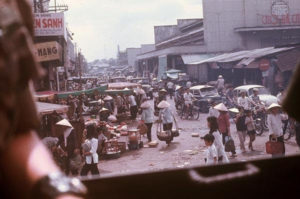 |
| I spent time with American GI’s who showed me their “Shoe Shine Boys Project.” It was created in response to the predominance of street children whose families couldn’t afford to care for them because of the war. Many of the boys were shining shoes to earn money for the family and most could not return home except to take their hard earned money. The GI’s leased homes in back alleys for these youth, where they had a bed, were fed warm meals and offered classroom instruction. The GIs took me to some of those homes. It was rather interesting that while the U.S. military was creating havoc and tragedy in Vietnam, some GI’s were attempting to alleviate what they could of this pain. I don’t know where the funding came from for this project or whether the US army was also involved to better control the shoe shine boys who were sometimes implicated in spying and/or working for the Viet Cong. Clearly everyone wanted to manipulate the youth. Nevertheless, the soldiers I talked with were proud of this project and rightly so. It’s also my understanding that actor Richard Hughes played the leading role in creating the “Shoe Shine Boys Project”:
In 1968, as a conscientious objector, he (Richard Hughes) refused the Vietnam draft, only to borrow $1,500 and travel on his own to Saigon, where he helped found the Dispatch News Service — later it distributed Seymour Hersh’s exclusive on the My Lai massacre — and opened a shelter for street children called the Shoeshine Boys Project. (NY Times) |
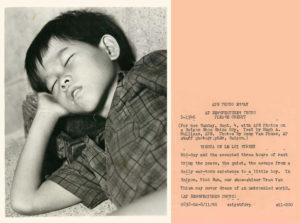 |
| Your copy should address 3 key questions: Who am I writing for? (Audience) Why should they care? (Benefit) What do I want them to do here? (Call-to-Action)
Create a great offer by adding words like “free” “personalized” “complimentary” or “customized.” A sense of urgency often helps readers take an action, so think about inserting phrases like “for a limited time only” or “only 7 remaining”! |
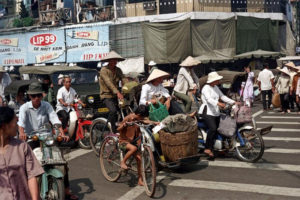 |
| 1973 in Saigon (Credit: Saigoneer)
I visited three orphanages in Saigon. The children in the first two were relatively well cared for and the institutions were clean, even in spite of what were probably relatively limited resources. They were administered by Vietnamese and not religious based. Then I visited the third orphanage administered by a French Catholic priest. I was utterly appalled. The children were filthy and groveling and crawling on dirty floors. Some of them were strapped in chairs outside. One child, the mixture of a Vietnamese and Black American, was blind and screaming. My colleague told me this Catholic priest was notorious throughout Saigon. His attitude was that it didn’t matter what happened here on earth because the rewards were to be found in heaven. This was, apparently, the priest’s justification for the abysmal treatment of these children. Not that all Christian orphanages are likely to be problematic or abusive, of course, but I’ve wondered since how often Christians apply this rationale.
In 1993 the Vietnamese Minister of Agriculture Visits Atlanta, Georgia
As a sequel to all this, in 1993, we in Atlanta were fortunate to host the Vietnamese Minister of Agriculture. The American Rice Institute had brought him to the United States. After visiting number of large corporate rice farms the Minister asked to visit a “real farm” in America. In response, the American Rice Institute called the Federation of Southern Cooperatives/Land Assistance Fund (Federation) so that the Minister could visit a small farm. At the time I was the Director of Communications for the Federation. I joined the delegation and we took him to visit Willie Adams, a Black farmer in east Georgia who raised chickens. The minister was clearly thrilled to finally spend some time with a “real farmer.” |
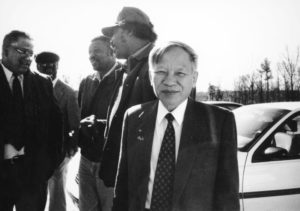 |
| In 1993 the Vietnam Agriculture Minister visits Georgia farmer Willie Adams (behind the minister) and Federation of Southern Cooperatives Executive Director, Ralph Paige is on the left.
(Photo: Heather Gray)
While on the road, the Vietnam Minister asked about the fate of US Vietnam War veterans. I told him many struggled economically and psychologically, many were homeless, some were on death row, many were haunted by the experience, many joined organizations to resist war, many were seemingly not effected, on and on. In very much an Asian “sense of place” and one in which the ancestors are honored, he told me “we know many young Americans died on our soil and their souls are with us now. We will always pray for them.”
Summary
I had visited Saigon in January of 1973. By March 1973, due to the Paris Peace Agreement, the US military began to withdraw from Vietnam. The total number of Vietnamese soldiers and civilians killed varies from 900,000 to 4 million. The total number of Americans killed is approximately 58,000. This does not include thousands of injuries, destabilization and death in the surrounding countries such as Cambodia, plus environmental degradation in Vietnam. What insanity is this?
All of us also need to attentive to the on-going tragic war against Ukraine by the Russians. This tragedy needs to end!!!
(This is an edited version of the article that first appeared on Counterpunch in 2007.) |


